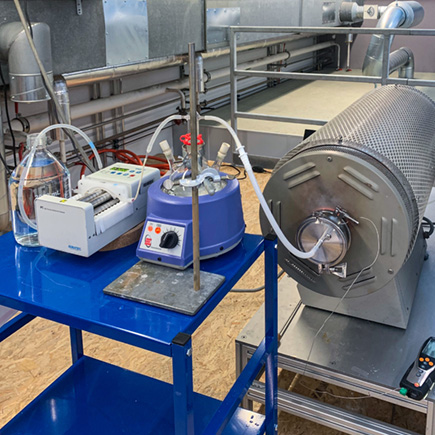Production of solar fuels: Storing the sun’s heat at 1,200 degrees
High-temperature bricks - a joint development by Empa and Synhelion – serve as temporary storage for the enormous heat
The ETH spin-off Synhelion has recently inaugurated the world's first industrial plant for the production of solar fuels in Germany. The heart of the plant contains a piece of Empa technology: Together with Synhelion, Empa researchers have developed a material for the high-temperature thermal energy storage system that allows the plant to remain in operation 24/7.

Closing the CO₂ cycle by converting climate-damaging carbon dioxide back into kerosene, gasoline and diesel: That is the idea behind Synhelion. The ETH spin-off uses the heat of the sun to produce synthetic fuels (Synfuels) from CO₂ and water. In June 2024, in the German city of Jülich, Synhelion inaugurated DAWN: the world's first industrial plant for the production of solar fuels. Thanks to a collaboration with the Empa Laboratory for High-Performance Ceramics, DAWN can produce renewable fuels around the clock – even at night.
To turn CO₂ and water back into fuels, DAWN needs one thing above all: energy. A large mirror field focuses the sunlight onto a single point on the solar receiver. The steam inside reaches a temperature of up to 1,200 degrees Celsius thanks to the concentrated energy of the sun. This high-temperature process heat is used to operate the reactor, while the surplus is fed into the thermal energy storage: a chamber several cubic meters in size, filled with very special bricks. These bricks – a joint development by Empa and Synhelion – serve as temporary storage for the enormous heat. Overnight, it is this heat reservoir that supplies the reactor with energy and keeps it running.
Wanted: the "super-brick"

At 1,200 degrees, though, not all bricks are created equal. In direct contact with the ultra-high temperature steam, even ceramics corrode. None of the refractory bricks available on the market were designed for these extreme conditions, so Synhelion approached Empa.
"The research group led by Empa researcher Gurdial Blugan is one of the few to study the corrosion behavior of ceramics at such high temperatures", says Lukas Geissbühler, Head Thermal Systems at Synhelion.
In a two-year project funded by Innosuisse, Blugan and Empa scientist Sena Yüzbasi, together with Synhelion, set out to find a suitable ceramic. Corrosion resistance was only one aspect. The material also had to have a high heat capacity, be mechanically robust and withstand thermal shocks that can occur when the system is powered down. It also had to be inexpensive to produce, because the plant in Jülich is just the beginning for Synhelion.
The researchers designed their own high-temperature tube furnace together with the Empa workshop and Synhelion. In it, they exposed different ceramic samples to the corrosive steam atmosphere – for up to 500 hours.
"It got pretty hot in our lab during these experiments," says Blugan.
But the sweating was worth it: The researchers were able to find a material that could withstand the extreme conditions.

Together with their project partners, they refined the material composition and optimized the manufacturing process in order to further improve the material properties and reduce costs. The bricks were then produced by a partner company in Germany and installed in Jülich.
"As a researcher, it's not often that you get to see your research applied on such a scale, it is quite a unique experience," says Yüzbasi.
The scientist, who now works in the energy industry herself, is particularly pleased that her work is being used in the renewable energy sector for climate protection.
Forging on together
"Empa has made a valuable contribution to the development of our thermal storage unit and was able to respond to Synhelion's specific requirements thanks to its flexibility," says Lukas Geissbühler.
While DAWN is going into operation, Synhelion and Empa are already planning their next joint project. For future plants, they want to further develop the material and make it even more durable. Synhelion's second plant for the production of solar fuel is to be built in Spain from 2025. The goal: even larger heat storage units, even higher temperatures. Since the higher the temperature, the more efficient the fuel production.

Source: EMPA, press release, 2024-09-19.
